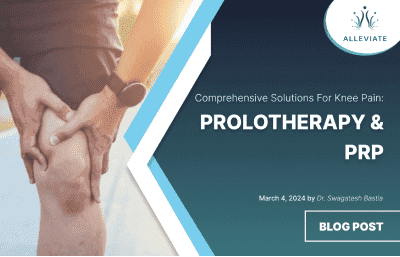

Prolotherapy
- Home
- Conditions
- Regenerative Treatment
- Prolotherapy
What is Prolotherapy?
Prolotherapy is a medical treatment aimed at repairing and strengthening injured or weakened connective tissues. By injecting a mild irritant solution into the affected area, it triggers an inflammatory response, encouraging the body’s natural healing mechanisms to repair damaged tissues.
Prolotherapy is the injection of an irritant solution (usually a form of sugar called dextrose) into joints, ligaments or tendons. It usually involves three to four or more shots given monthly for several months, followed by occasional, as-needed injections.
In people with osteoarthritis (OA), the 80-year-old therapy is most often used to treat join pain in the knees, fingers and thumbs. Most doctors who treat OA, however, use prolotherapy rarely, if at all.
This treatment is meant for injured joints and connective tissue. It’s also used to treat some people who have conditions like arthritis, whiplash, and degenerative disc disease. Prolotherapy can treat a number of areas of your body, including your back, neck, knees, shoulders, hips, pelvic floor, and hands.Because pain is an indication of tissue damage, the pain can be eliminated permanently as the tissue heals after the Prolotherapy treatment series. The term “Prolotherapy” was first used by George Hackett, MD, and has been derived from the word “proliferate”, which means to rapidly grow new cells. These newly created cells can cause hard-to-heal areas, such as ligaments, to repair, strengthen and tighten over time, restoring a painful, unstable joint, into a stable and healthy one.
How Prolotherapy works
Mechanism of Action
Prolotherapy works by inducing a localised inflammatory response at the site of injury. This response increases blood flow and attracts immune cells to the area, facilitating tissue repair and regeneration. The injected solution, often a dextrose-based solution, acts as an irritant that triggers this healing cascade.
Types of Solutions Used
- Dextrose: The most common solution used in Prolotherapy. It acts as an osmotic agent, causing mild irritation and promoting healing.
- Platelet-rich plasma (PRP): Concentrated platelets from the patient's blood, used to enhance the regenerative process.
- Stem Cells: Stem cells harvested from the patient's bone marrow or adipose tissue are used in advanced cases for enhanced tissue regeneration.
Treatment Process
Initial Consultation
A thorough medical history and physical examination to determine the suitability of Prolotherapy for the patient.
Injection Procedure
The area to be treated is sterilized, and the solution is injected using precise techniques to ensure accuracy and efficacy.
Post-Treatment Care
Patients may experience temporary discomfort and are advised to avoid anti-inflammatory medications to allow the healing process to occur naturally.
Video Spotlight
Blog
Surgery-Free Solutions
Expert Tips for Pain Management
Testimonials
Words From Our Patients
The treatment was very good and the doctor Faraz Ahmed was very kind to the patient and explained clearly the procedure of knee bilateral ha & botox And we were advised to do physiotherapy. We are very much satisfied. We would recommend this alleviate pain clinic.Thank you
Got treatment of Botox and HA for right knee arthritis a month ago and finding good relief from pain. Was treated by Dr Swagtesh Bastia who explained very well about the injections and the treatment was painless. The front desk staff were very kind and very helpful and physiotherapy was also done expertly, overall good experience
Alleviate Pain Management clinic has been a godsend for my mom's knee pain. She has been treated by Dr. Wiquar Ahmed. The attentive staff provided personalised care, and after her treatment, she's feeling remarkably better. Thank you for giving my mom the relief she deserves!
The clinic is super clean with a great OT and most importantly all the staff here are very helpful and considerate. My gratitude to Dr Roshan, the nurses, and support staff - they were always available to assist with any issues post procedure and they even made an extra effort to make a home visit for a follow up check-up. This team here is the perfect example of healing and care with a human touch. Thank you!!!!!
My wife had knee pain I have visited alleviate pain and consulted doc santhoshi now she is able to walk pain free and can do her daily activity than before.the physiotherapist here Dr akhila also helped her with few exercises and the staff here Abdul explained all the procedures well . Thank you PPL can visit here for pain relief





